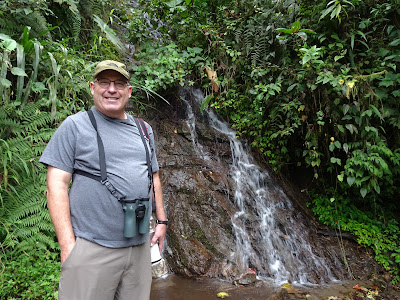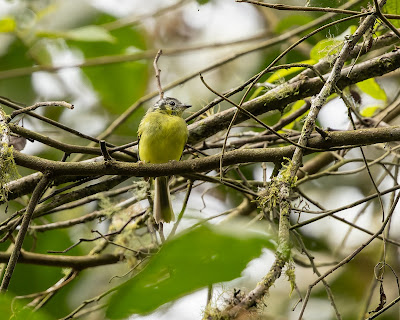Monday 9/13/21 (Teri)
We all met out on the deck at 6 am. The lodge has a white sheet that they keep a black light on during the night. It’s great to see interesting insects and the birds love them!
Breakfast was 7 – 7:30 am. Eggs over-easy on toast with some very strong cheese and bell pepper.
We got all our stuff together (binos, cameras, walking sticks, etc.) and hit the trails at 8:00.
The trail was very steep up and down and had a lot of rocks and tree roots. I was having a pretty hard time even with a walking stick and Mark had to help me on most of the down hill parts.
We got back to the lodge about 11:00 and found that 4 other people had arrived to stay at the lodge. Luckily they only stayed for 2 nights. They were very impolite birders!
Lunch was at noon. It started with green lentil soup which was very good. Spaghetti and meatballs with a light dessert ended the meal.
Everyone relaxed until 2:30 then we headed down the driveway to do some birding along the road.
When we got down the road
Edison (our driver) picked us up and we drove to another area. Along the way we stopped to see a baby
Cock-of-the-Rock. He was super cute!
The driveway up to the lodge
is extremely steep. We had been having
rain and it was also quite slick. After
a couple of attempts, Edison decided he could not get the van up the hill. We were not too far from the top so we all
got out and walked the rest of the way.
Dinner was at 6:30 and started with kale soup. Every lunch and dinner we had at the lodge started with soup. The kale soup was the only one that I didn’t care for. The rest of dinner was fish with white rice, plantain chips, 2 tiny beets and for dessert, a tree tomato (edible fruit from the Tamarillo tree). We went over the bird list after dinner and then headed to our room for the evening.
Monday, 9/13/2021 (Mark) - Got up at 5:30, and met on the deck to view hummingbirds and other species at 6:00. We started by looking for insect-eating birds at the black-light setup. The black-light attracts insects, which land on a white sheet. Early in the morning forest-dwelling birds that are otherwise tough to find visit the set-up for an easy meal.
The Crimson-rumped Toucanet and Toucan Barbet were active on the fruit feeder in front.
There was also an interesting Flame-rumped Tanager. It appeared to be a young male that was molting into his jet-black adult plumage. For this species, the juvenile plumage resembles that of the plainer female, in this case yellowish. So this young fellow was rocking an interesting mix of yellow and black!
At 7:00 we had breakfast, then at 8:00 we headed down the Potoo trail at the lodge.
We birded along this steep and rocky trail until 10:45
but didn’t see a lot of birds. This often seems to be the case on narrow forest trails. We did pick up Plain Antvireo and Slaty Antwren,
along with Grey-breasted Wood-Wren, and Pale-eyed Thrush. We also had nice
looks at a female Red-headed Barbet. But pictures are tough to get in the deep, dark forest!
We came back and birded and photographed on the decks, but there were 4 French men that were standing literally 2 or 3’ feet from the various hummingbird feeders with their cameras and didn't care one bit that they were blocking the view for others, so we finally just found a different area to sit and relax.
Lunch was at 12:30, and at 2:30 we walked down the drive,
birding along the way. At the bottom we got in the van and drove the road to
bird the “Lower Tandayapa Valley” by stopping at a few different spots and
walking. We didn't see a lot of birds, but did get decent looks at Montane Woodcreeper and Marble-faced Bristle-Tyrant. There are around 10,000 species of birds in the world, so you can see why some of these complex and imaginative names are necessary!
At one place we stopped and José asked if we’d like to see a female Cock-of-the-Rock nest. I thought he was kidding, but sure enough there was a hollowed out place in a mud bank alongside the road, with a female Cock-of-the-Rock sitting in it. She flew pretty quickly, leaving behind a truly ugly nestling with stringy “hair” sticking out from the top of its head and an oversized bill. It looked like a Pterodactyl. Later José called in a nice Golden-headed Quetzal male.
We ended the trip standing on the road for what seemed
like 30 minutes trying to call down a Cloudforest Pygmy-Owl, but it never came
down.
The drive back to the lodge went well until we got onto the incredibly steep cobblestone drive going up to the lodge from the road. It had drizzled some and the road was very slick. We got stuck on the last part with spinning tires. Edison backed down twice and tried to get up some momentum, but we spun out each time. We finally got out and walked the last 50 yards back up to the lodge. Dinner was at 6:30, then we did the bird list and called it a night. We’d picked up some good birds, but overall it seemed like kind of a slow day.
Next time: Milpe Bird
Sanctuary






















I love how you focus on different aspects of the day. I am interested in the menus and how often they wouldn't be appealing to me! Eggs on toast....no thank you.
ReplyDeleteI was wondering about the rude birders and then Mark defined them
So if there are 10,000 birds, how many have you seen?.
The food definitely wasn't a highlight of this trip. We have seen about 1,400 bird species. I'm sure there are a few we missed counting but 1,400 is pretty close.
ReplyDeleteI have a similar question. Of the 10,000 species, how many do you think you have memorized? I know you study before going on a trip to refine the likely birds you will see, but you two have been to a lot of places.
ReplyDeleteAlso, that is one ugly baby bird.
ReplyDeleteThat's a hard question to answer. We will study a few hundred birds for trips. Some of the names stick with us for years, others we forget and are replaced by new birds we're learning.
ReplyDeleteI think we'll remember what a baby Andean Cock-of-the-Rock looks like for the rest of our lives.
As will we😁
DeleteThat is an interesting question Randy. We have seen 550+ species in the US, and I am comfortable saying that all of those are committed to memory. Of the "foreign" birds, I would guess another 400 - 500 are memorized. So perhaps 2/3 of our total (1000 +/-) are pretty well learned. But there are thousands of species on other continents that we've never so much as looked at. We need to change that...
ReplyDeleteI knew that was an impossible question, but over 1000 is really impressive.
DeleteYes, so many places to go and explore. Thanks for sharing with us.